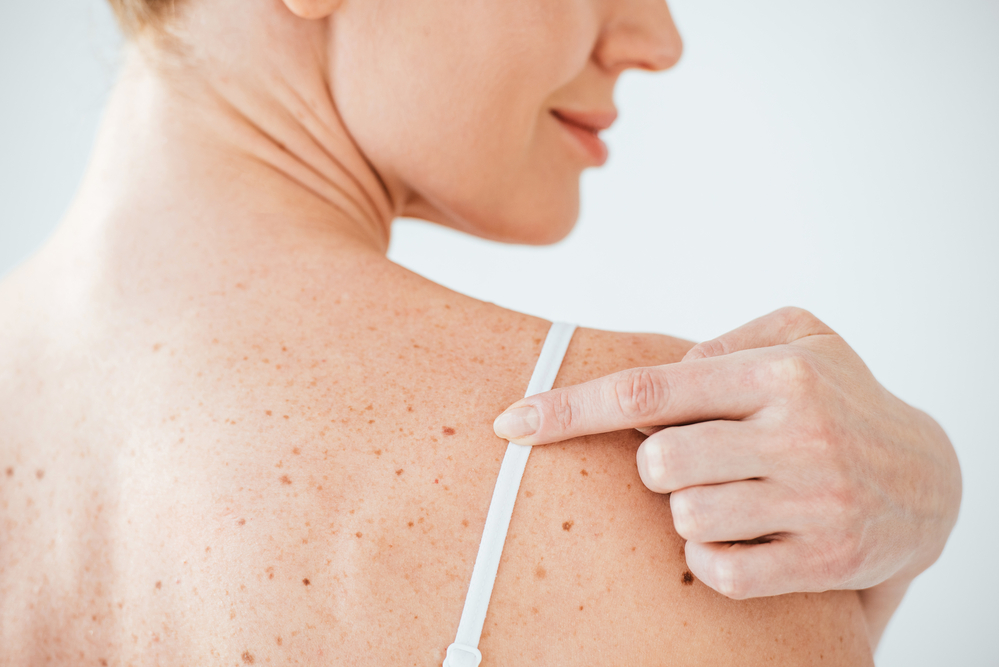It’s very common to have moles on your face, arms, and other areas. There are a number of reasons why you might want to remove some of your moles. For example, your moles might rub against your clothing or cause you to feel upset about your appearance. If you are experiencing these issues, you should think about receiving a mole removal treatment from the Dermatology Center of Acadiana in Lafayette and Breaux Bridge, LA.
How Long Does Mole Removal Take?
We can use a variety of different methods to remove your unwanted mole. The mole removal technique that we use will depend on the type of mole that we are eliminating, your preferences, and other factors. Although the specific length of your appointment will depend on the technique that we use to treat your mole, all of our removal methods will be very quick and easy. In fact, it will usually take us less than one hour to treat an unwanted mole.
We will probably begin by taking measurements and photographs of your unwanted mole. Next, we will sterilize the skin in this location and use local anesthesia to numb your tissues. You will probably need to wait for a short period of time for this medication to take effect. Next, we will use specialized tools to carefully remove your mole. You will usually be able to leave our office as soon as we have finished treating your mole.
When Should I Receive a Skin Check?
Receiving regular skin checks is a good way to protect your health. During a skin check, we will examine all of the moles on your body. We will use our training and experience to identify moles that look atypical, precancerous, or cancerous. Depending on your situation, we may advise you to remove these moles. If cancerous moles are identified and addressed at an early stage, your treatment will be much more likely to be successful.
There are a number of characteristics that may indicate that a mole could be cancerous. These features are called the ABCDEs of skin cancer. If you have a mole that displays any of these characteristics, you should schedule a skin check.
A Stands for Asymmetry
Many moles have uniform shapes. A mole is asymmetrical if each half of the mole has a different size, thickness, or shape. In addition, the sides of your mole might be different colors.
B Stands for Border
If you have a mole with irregular or badly defined borders, you should schedule a skin check with a healthcare professional.
C Stands for Color
Some moles contain a variety of different colors. For example, you might have a mole that contains varying shades of black and brown. Alternatively, your mole might include shades of blue, red, or white. If any of your moles are multi-colored, you should schedule an appointment for a skin check.
D Stands for Diameter
You should watch for moles that have diameters of at least six millimeters. This is about the size of a pencil eraser. It’s important to have these large moles analyzed by a professional.
E Stands for Evolving
If one or more of your moles is changing, you should have a skin check. For example, your mole might become larger or change color over time. In addition, the shape of your mole may start to evolve.
What Factors Increase My Risk of Developing Skin Cancer?
Although anyone can develop this health problem, there are a number of characteristics that will increase your chance of suffering from skin cancer. In particular, you will be more vulnerable if you spend a large amount of time in the sun. If you have a history of experiencing sunburns, you will also have a higher risk. In addition, you will be more likely to develop skin cancer if your relatives have experienced this health issue.
Your moles will also impact your risk of experiencing this problem. If you have a large number of moles or have developed abnormal moles, your risk will be higher. If you have many moles or other risk factors, we may advise you to receive more frequent skin checks.
What Type of Moles Do I Have?
It’s common to develop new moles over time. You can have acquired moles, atypical moles, Spitz nevi, and many other types of moles.
Acquired Moles
A mole that you develop after birth is called an acquired mole. Most of these moles are harmless. If you have lighter skin, you will be more likely to develop additional moles over time. In fact, you will probably develop 10 to 40 new moles during your life. If you have darker skin, you might develop two to five new moles during this time.
Spitz Nevi
Spitz nevi are dome-shaped moles that will usually appear before you reach the age of 20. However, you can also develop this type of mole at a later time in your life. Although these moles are usually pink, a Spitz nevus may also be brown, red, or other colors. Since these moles can look like a type of skin cancer called melanoma, it’s important to have Spitz nevi analyzed during regular skin checks.
Congenital Moles
Moles that you have had since birth are called congenital moles. These moles have a variety of different sizes. If you have large congenital moles, you will have a higher risk of experiencing melanoma.
Atypical Moles
Atypical moles are growths that have irregular features. For example, these moles might have asymmetrical shapes. An atypical mole could also contain multiple colors. For example, your mole might be black and brown. Although these moles can develop in any location, they are more likely to form on your scalp, torso, or neck.
These types of moles are also known as dysplastic nevi. If you have a family or personal history of melanoma and more than four atypical moles, you will have a higher risk of developing this health problem. As a result, you will need to visit our office for regular skin checks. During these meetings, we will monitor your atypical moles and look for any changes in these growths.
Will My Health Insurance Pay for Me To Remove My Unwanted Mole?
When we examine your skin, we will use our training and experience to analyze the condition of your moles. If we see a mole that looks atypical or cancerous, we may advise you to remove this mole and receive a biopsy. Your biopsy will determine whether your mole was malignant, atypical, or benign. In general, your health insurance will cover the cost of this type of mole treatment.
Alternatively, you might decide to remove one of your moles for cosmetic reasons. For example, you might decide to remove a noticeable mole on your face or eliminate a mole that rubs against your clothing. Although your insurance is unlikely to cover the costs of this type of removal, our mole treatments are very affordable. As a result, eliminating your mole is a cost-effective way to improve your appearance.
What Techniques Will Be Used To Remove My Unwanted Mole?
We can use a shave, surgical, or punch excision technique to address your unwanted mole.
Receiving a Shave Excision
If you have a raised mole, we may use a shave excision method during your appointment. We will start by using an antiseptic to clean your target area. Next, we will numb your skin with a local anesthetic. After this medication has numbed your tissues, we will use a razor-like tool to carefully eliminate your mole. Once we have removed your mole, we will use a special feathering technique to reduce the visibility of your excision.
During this part of your appointment, we will use a small electrode to blend the edges of your excision with the rest of your skin. This technique will decrease inconsistencies in this location. After we complete this process, we will apply a sterile bandage onto your skin. Since this technique is very gentle, you will not need to receive stitches during your appointment.
Getting a Surgical Excision
If you have a larger mole, we may use this method to eliminate this growth. After we have cleaned and numbed your skin, we will use a special instrument to cut out your unwanted mole. This method will allow us to reach deeper layers of your skin. After we have finished your mole removal treatment, we will use biodegradable stitches to close your incision. Over time, your skin will naturally absorb the material in your stitches.
Receiving a Punch Excision
During a punch excision, we will use a small blade to put pressure onto your target area. Next, we will use a special tool to punch out your mole. After we have removed your mole, we will probably use one or two biodegradable stitches to close your incision.
What Will Happen After My Mole Removals?
After we have applied your bandage, you’ll be able to drive home, go to work, or run errands. Although your aftercare instructions will be personalized, we will probably tell you to follow some basic rules.
Caring for Your Skin
After we remove your unwanted mole, we will teach you how to care for your treatment area. For example, we may instruct you to clean your excision site with water and antibacterial soap. In addition, we may ask you to apply petroleum jelly onto your skin and put new bandages over your excision site. You might also need to take over-the-counter medications while your skin is adjusting to your treatment.
While your tissues are healing, you should avoid exposing your excision site to strong sunlight. You can achieve this goal by covering this area with clothing when you go outside.
Receiving Your Biopsy Results
Under some circumstances, your mole might need to be biopsied. For example, if your mole has an irregular border or is very large, we may send it to a scientific laboratory for testing. This laboratory will analyze your mole and determine if it is benign or cancerous. Depending on the results of your biopsy, we may refer you to a skin cancer specialist or another healthcare provider.
Schedule a Consultation
You shouldn’t ignore a mole that rubs against your clothing, negatively affects your appearance, or displays warning signs of skin cancer. Our mole removal Lafayette LA techniques are quick, comfortable, and effective. Removing your unwanted moles will improve your appearance and protect your health. To learn more about this treatment, contact us at the Dermatology Center of Acadiana in Lafayette and Breaux Bridge, LA.

